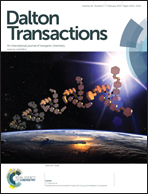Four tetrazolate-based 3D frameworks with diverse subunits directed by inorganic anions and azido coligand: hydro/solvothermal syntheses, crystal structures, and magnetic properties†
Abstract
Four tetrazolate (tz−)-based magnetic metal–organic frameworks, [Cu5(μ3-OH)2(SO4)2(tz)4]n (1), {[Cu3(tz)4Cl2]·1.4CH3OH}n (2), [Cu(N3)(tz)]n (3) and {[Cu5(tz)9]Cl·4H2O}n (4), were hydro/solvothermally synthesized, and structurally and magnetically characterized. Structural analyses reveal that the former two samples exhibit the same eight-connected topological framework assembled from different subunits. Hourglass-shaped {Cu5(μ3-OH)2}8+ cores in 1 are periodically extended by mixed μ3-/μ4-tz− and μ4-SO42− heterolinkers, while the linear {Cu3(μ-Cl)2}4+ blocks in 2 are repeatedly intersected by ditopic μ3-tz− connectors. In contrast, the square grid-shaped network of 3 is constructed from linear {Cu(μ1,1-N3)}+ chains and μ3-tz− linkers. Complex 4 consists of trigonal-prismatic {Cu8(μ3-tz)6}10+ subunits, which are interlinked into hexagonal microporous architecture by mirror-symmetry μ4-tz− ligands. Thus, the various subunits of 1–4 are significantly tuned by the co-coordination of the inorganic anions and/or the azido co-ligand, and the backbone extensions are directed by the polytopic tetrazolate ligand. Magnetically, different ordering arrangements of the non-zero magnetizations produced in the local CuII5 and CuII3 subunits eventually lead to unusual ferrimagnetic and canted antiferromagnetic properties in 1 and 2. Strong antiferromagnetic couplings mediated by the mixed tz− and/or azido bridges result in overall S = 0 spin ground-states of 3 and 4.


 Please wait while we load your content...
Please wait while we load your content...